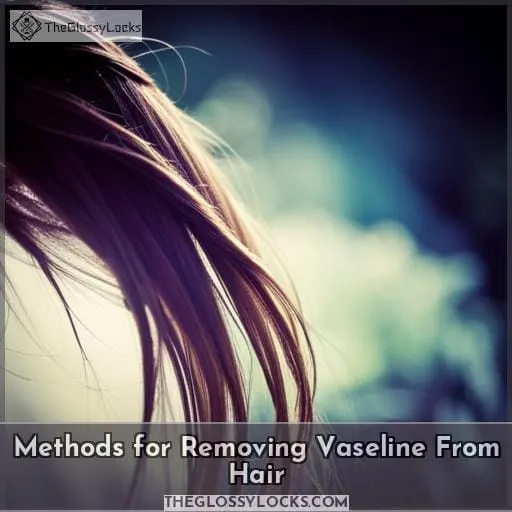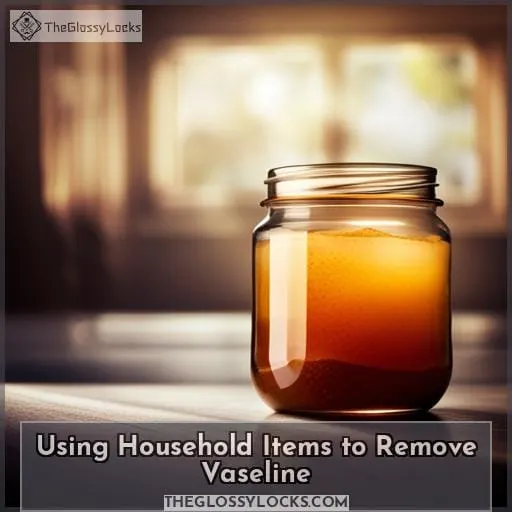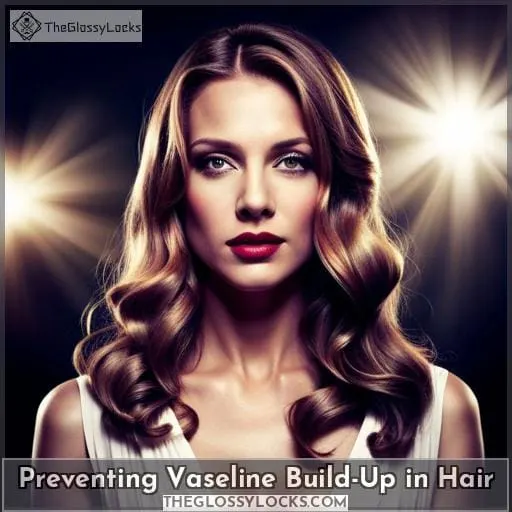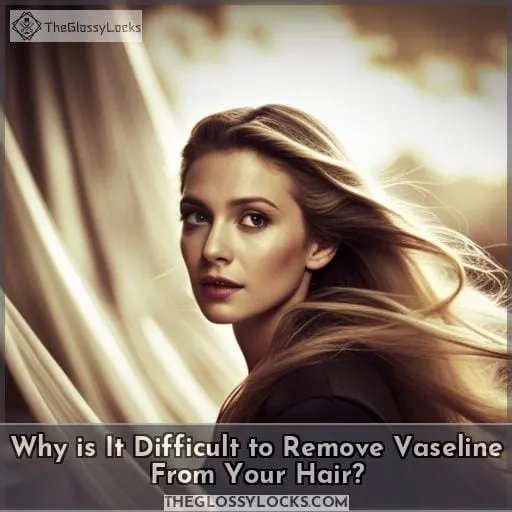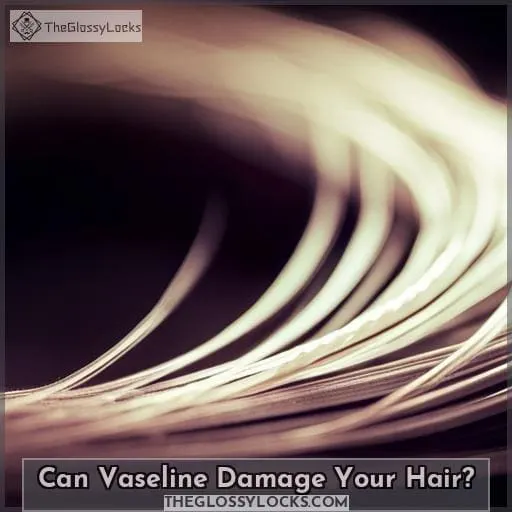This site is supported by our readers. We may earn a commission, at no cost to you, if you purchase through links.
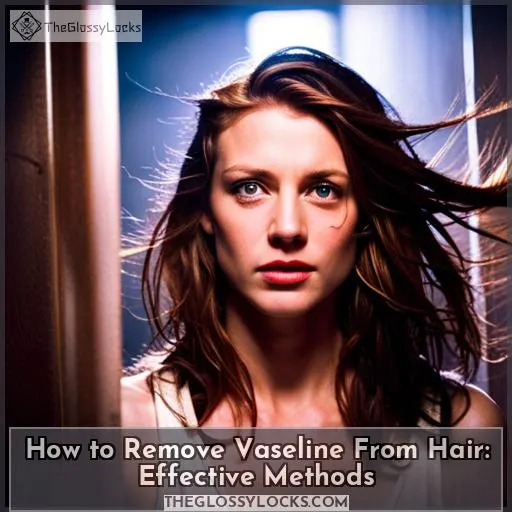 Picture a greasy Vaseline-coated mess on your head, and you don’t know how to remove it. We’ve all been there. Whether you used too much of the product or it got into your hair by accident, knowing how to get Vaseline out of your hair is essential.
Picture a greasy Vaseline-coated mess on your head, and you don’t know how to remove it. We’ve all been there. Whether you used too much of the product or it got into your hair by accident, knowing how to get Vaseline out of your hair is essential.
Fortunately, there are several methods that can help make sure this never happens again! In this article, we’ll explore the most effective ways to remove Vaseline from hair. We’ll also discuss why it’s difficult in the first place and what its effects on our locks may be.
Read ahead for some useful tips and tricks for getting rid of excess petroleum jelly in no time!
Table Of Contents
Key Takeaways
- Removing Vaseline from hair can be challenging due to its non-water-soluble nature.
- Effective methods for Vaseline removal include clarifying shampoo, dish soap, and baby shampoo.
- Vaseline buildup on the scalp can lead to hair loss, breakage, and irritation.
- Prevent Vaseline buildup by using deep-cleansing or clarifying shampoo.
Methods for Removing Vaseline From Hair
You may be wondering how to get Vaseline out of your hair. Fortunately, there are several methods for removing it that range from using clarifying shampoo or dish soap to more specialized products like baby shampoo, cornstarch or talc, glycerin soap, and oil-based soaps.
Clarifying Shampoo
If you’ve applied Vaseline to your hair, be sure to use a clarifying shampoo to help remove any buildup and restore healthy locks. To prevent further damage, clarify with warm water and a deep cleansing shampoo.
Massage the scalp thoroughly for best results. Follow up with a hydrating mask or conditioner afterwards.
Vaseline can clog follicles, leaving your hair greasy and weighed down if not removed properly, so using an effective cleaning agent is necessary for maintaining its health! Be mindful of how often you apply it as well; too much product can lead to breakage over time due to excessive build up on strands.
Dish Soap
Give dish soap a try as an effective degreaser for Vaseline buildup. Try substituting shampoo on areas with the most buildup, then rinse and follow up with a hydrating hair mask.
Squirt the remover onto your hand and rub it through greasy areas before rinsing away all traces of petroleum jelly.
With its oil-based solutions, baby oil can dissolve Vaseline too; just massage into affected hair for 10 minutes before blotting out excess with paper towels.
Finally, don’t forget about glycerin soap when removing stubborn Vaseline buildups from your tresses!
Baby Shampoo
Try massaging baby shampoo into the affected areas of your hair and let it sit for 10-15 minutes to help dissolve any Vaseline residue. Use a gentle formula as regular shampoos can be too harsh on delicate strands. Blot excess Vaseline with paper towels before applying.
Then, work in the shampoo slowly from scalp down to ends. Rinse thoroughly and follow up with a hydrating conditioner or mask if necessary.
Baby shampoo is an effective way of removing stubborn petroleum jelly buildup without damaging your hair.
Cornstarch or Talc
Pat cornstarch or talc onto greasy parts of your hair to absorb oil and remove any Vaseline buildup. Talc is best for absorbing excess grease, while cornstarch works better as a moisturizer.
Be sure to isolate the affected areas before applying either powder. This will prevent the product from spreading too much on other hair sections.
Make sure you use enough powder so that it covers all Vaseline-affected parts. Be gentle when massaging it in order to avoid pushing petroleum jelly further into strands.
Rinse off with warm water afterwards, then shampoo gently and condition thoroughly for soft, clean tresses!
Glycerin Soap or Oil-Based Soap
Gently massage glycerin soap or oil-based soap into your hair like a soothing lullaby to help dissolve stubborn Vaseline. Glycerin soap benefits include moisturizing and protecting the scalp without stripping natural oils.
Oil-based soap comparison shows that it is better for removing sticky substances from hair than shampoo, offering more nourishment and hydration.
For effective Vaseline removal with either of these soaps, start by blotting excess product with paper towels. Then, apply the soap to affected areas and rinse thoroughly with warm water until all traces of petroleum jelly are gone.
Hair care tips suggest using conditioner after dish soap for extra moisture, then rinsing in cool water to seal cuticle layers.
Using Household Items to Remove Vaseline
If you’re looking for an effective solution to remove Vaseline from your hair, baking soda, baby powder, vinegar, and oils are all great options. Baking soda is a natural cleanser that can absorb oil, while baby powder works similarly by absorbing the excess moisture.
Vinegar is also known as a degreaser, which can help break down the petroleum-based product in Vaseline. Baby oil or other oils like coconut or olive work well to dissolve Vaseline as they have high viscosity levels, which make them easier to spread throughout your hair without leaving behind residue afterward.
Baking Soda
Sprinkle some baking soda onto your oily areas, then massage it in for a few minutes to help absorb the Vaseline.
Baking soda can be used as an alternative to other removal methods such as apple cider vinegar or oil. It’s great at absorbing grease and oils from hair without stripping away natural moisture or causing scalp irritation like petroleum jelly can do if left on too long.
Remember: always follow up with a nourishing conditioner after using harsh degreasers like baking soda so you don’t damage your hair further due to dryness & breakage caused by Vaseline buildup!
| Method | Benefits |
|---|---|
| Sprinkling Baking Soda | Absorbs grease & oils from hair without stripping moisture |
| Apple Cider Vinegar | Effective remover of traces of petroleum jelly |
Baby Powder
Try using baby powder to absorb Vaseline buildup in your hair. Coat greasy areas with a soft layer of the talcum-like substance for an extra layer of protection.
Wash with warm water and shampoo. Repeat if necessary after 12-24 hours. Baby oil can also dissolve it. Massage into affected areas, then wipe out any residuals with paper towels before rinsing thoroughly.
Use moisturizing conditioner afterwards to prevent dryness from harsh detergents used in the removal process. Additionally, use glycerin soap to lather up those hard-to-reach spots for deep cleansing action! An ACV spritz may help too.
Vinegar
Spritz apple cider vinegar onto the affected areas to dissolve Vaseline buildup and wipe downward. ACV’s natural acidity helps break down petroleum jelly, while its antibacterial properties can help balance scalp health.
Additionally, its high vitamin content supports hair growth and healthy follicles.
Furthermore, it is a versatile ingredient with benefits for both skin and hair care. It can remove product build-up from styling products or grease residue from Vaseline on your strands! For best results, use a mild formula that won’t strip away oils needed for proper hydration.
Focus shampooing on problem spots before massaging thoroughly, then rinse with warm water.
Baby Oil or Other Oils
Gently massage baby oil into affected areas of your hair for 10-15 minutes to dissolve Vaseline and restore softness.
Olive, coconut, jojoba, and almond oils are all excellent natural options that penetrate the hair shafts with their replenishing nutrients.
You can also use eggs as a Vaseline remover; whisk them up and apply like shampoo before rinsing off thoroughly.
Lastly, try using liquid dish soap or degreaser—it works surprisingly well!
Be sure to follow it up with a hydrating mask or conditioner afterwards so your locks stay healthy looking without any damage from overuse of harsh chemicals on petroleum jelly build-up.
Preventing Vaseline Build-Up in Hair
Prevent Vaseline buildup in your hair by using deep-cleansing or clarifying shampoo and following up with a nourishing mask for extra hydration. Choose shampoos that are specifically designed to break down petroleum jelly, as regular shampoos may not be strong enough.
Start by washing the scalp and areas of heaviest product build-up first, then move on to other parts of the head after achieving lather throughout the entire area.
Afterward, use a moisturizing conditioner to replenish moisture lost during cleansing and prevent dryness from occurring later on. To keep greasy hair at bay long term, focus on keeping your scalp clean with frequent washings (twice per week is adequate).
Don’t forget about proper nutrition; eating healthy fats like avocado can also help maintain healthy locks free from Vaseline residue! Finally, if all else fails, consider investing in professional services such as color treatments, which can strip away stubborn residues naturally without damaging strands further than they have already been caused by grease build-up itself.
Understanding Vaseline and Its Effects on Hair
Understanding the effects of Vaseline on your hair is critical. For example, it can cause scalp irritation and buildup that leads to breakage. Petroleum products like Vaseline are not water-soluble, making them hard to remove with regular shampooing.
Without proper removal techniques, you risk clogging up pores and weakening strands due to lack of moisture or nourishment.
To ensure healthy locks without sacrificing natural oils in your scalp, consider using alternative moisturizing agents such as coconut oil or almond oil instead. Both have been known to be effective in keeping hair hydrated without weighing it down.
Additionally, if looking for something more lightweight, try out a deep conditioning mask after every wash session! This will help replenish vital nutrients needed by the follicles, which can become weakened due to excessive petroleum product use over time.
With these simple tips and tricks, you’ll maintain healthy tresses while avoiding any further damage caused by petroleum products like Vaseline!
Why is It Difficult to Remove Vaseline From Your Hair?
Removing Vaseline from your hair can be a challenge. It’s not water-soluble, making it difficult to wash out completely. Petroleum jelly buildup leads to scalp irritation and hair breakage, so you must take extra care when attempting this task.
Clarifying shampoos are essential for effective removal, but they should only be used on the areas with the most buildup while massaging thoroughly. Afterward, use a nourishing mask or conditioner to prevent dryness and seal in moisture before rinsing with cool water.
Household powders like baking soda or cornstarch can also help absorb the Vaseline residue – simply blot gently and pat powder onto greasy parts of your locks before washing off as usual with warm water and shampoo until all traces of petroleum jelly have disappeared! If necessary after 12-24 hours repeat this process once more for optimal results; otherwise enjoy having luscious soft tresses without any oily residue!
Can Vaseline Damage Your Hair?
Using Vaseline in your hair may seem like a good idea, but beware; it can be disastrous for your locks, leaving them dry and brittle – just like straw! Petroleum jelly is not water-soluble, making it difficult to remove from the scalp and hair.
This residue buildup leads to irritation of the skin as well as clogged follicles that can cause breakage. To prevent damage from occurring, use moisturizing shampoo with clarifying properties to cleanse away any buildup left behind by Vaseline or other products containing petroleum jelly.
Additionally, oiling benefits such as coconut or olive oil massaged into affected areas will help break down stubborn residues without causing further harm. Finally, incorporate regular deep conditioning treatments into your haircare routine for optimum split ends prevention and dandruff remedies.
Also, avoid overusing styling tools that could strip moisture from strands, leading to weak cuticles prone to snap easily under pressure!
Conclusion
It’s no secret that Vaseline can be a difficult product to remove from hair. Studies show that a single application of petroleum jelly can lead to a buildup of up to 40% on the scalp, causing hair loss, breakage, and irritation.
Fortunately, with the right methods and products, you can get Vaseline out of your hair without damaging it.
From clarifying shampoos and dish soap to baking soda and baby oil, there are a number of effective ways to remove Vaseline from your hair. Regular use of these methods ensures that your hair remains soft, healthy, and free of Vaseline residue.
Don’t let Vaseline buildup stand in the way of achieving your hair goals. Use the methods outlined above to get the Vaseline out of your hair and enjoy beautiful, healthy tresses.

